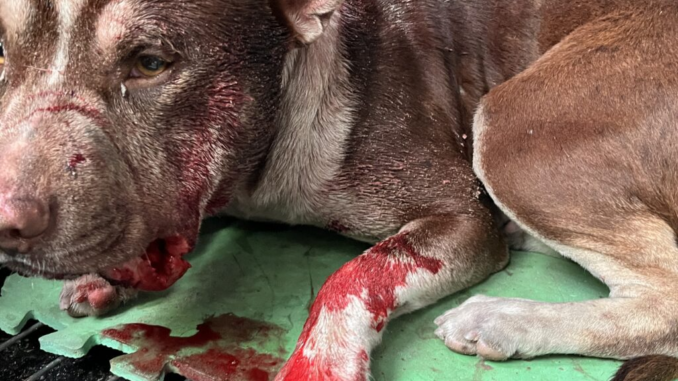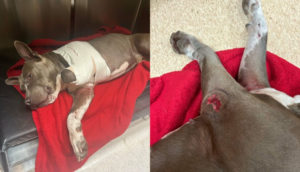
Introduction: A Desperate Cry in the Dark
It’s one of those heart-stopping moments that no animal lover can ever forget. On an isolated stretch of highway, a severely injured dog was left crying out for help, unable to move or escape the desolation of her situation. The sound of her desperate cries pierced the silence of the night, but fortunately, someone heard her plea.
This is a story of hope, rescue, and the power of compassion that led to the survival of a dog who might have otherwise been left to suffer alone. It’s also a powerful reminder of how animals, too, call out for help when they’re in need, and why we must be ready to answer.
The Scene of Despair: An Isolated Highway and a Dog in Pain
The highway was long and quiet, with few cars passing by. On that particular night, there was only the sound of wind and the occasional passing vehicle. However, among the otherwise tranquil stretch of road, there was an urgent cry for help—a cry that could not be ignored.
What Happens When an Injured Dog Is Left Alone?
When a dog suffers an injury, especially in an isolated location, their chances of survival without help are slim. In this case, the dog had been severely hurt—likely hit by a car or attacked—leaving her unable to move and in excruciating pain. Left alone, an animal in this condition could easily succumb to further injury, exhaustion, or even death.
For this dog, being left on such a desolate highway meant that survival depended entirely on being found. The cries she let out were the only way she could communicate her need for help, and fortunately, someone was there to hear them.
The Moment of Discovery: A Cry That Could Not Be Ignored
The sound of a dog crying out for help is unmistakable, and when someone passing by heard it, they knew something was wrong. The person pulled over immediately, driven by the need to help an animal in distress. What they found was heartbreaking—an injured dog, trembling and alone, stranded on the roadside, calling out for help.
Signs of Injury in Stray Dogs
In cases like this, it’s vital to recognize the signs of injury in a dog that might be stranded. The dog appeared to be unable to walk and had visible signs of trauma—likely broken bones or internal injuries—making it clear that immediate veterinary care was necessary.
Upon closer inspection, the rescuers could see that the dog’s condition was severe, but her cry for help seemed to give her the strength to keep holding on.
A Race Against Time: Getting the Dog to Safety
Time was of the essence. The moment the injured dog was found, the priority was to get her medical attention as soon as possible. The rescue team quickly loaded her into the vehicle, but the danger wasn’t over. The dog’s injuries were critical, and every minute counted.
The Importance of Immediate Veterinary Care for Injured Dogs
Dogs that are severely injured need immediate veterinary care to stabilize their condition. In the case of road accidents, dogs may suffer from broken bones, internal bleeding, or head trauma—all of which require urgent treatment. This is why finding and rescuing an injured dog quickly is so important.
The rescue team contacted the nearest emergency vet clinic and rushed the dog there. The team hoped the dog would survive long enough for treatment to begin, but there was no guarantee.
Veterinary Care: The Battle to Save a Life
At the clinic, the dog was quickly assessed by veterinary professionals. She was placed under intensive care as the team worked to stabilize her. The initial examination revealed that she had several broken limbs, possible internal bleeding, and severe dehydration.
What Happens in Emergency Veterinary Care?
Emergency care for injured dogs involves stabilizing the dog’s vital signs, addressing any life-threatening issues, and beginning treatment for their injuries. In this dog’s case, the vet team worked on managing her pain, administering fluids, and starting the process of repairing her fractures.
Although the road to recovery would be long, the fact that she had been found in time meant that there was hope.
The Healing Process: A Long Road Ahead
After several days of intensive care, the dog’s condition began to stabilize. She was still far from out of danger, but her heart-wrenching cry for help on the highway had sparked a chain of events that would give her a fighting chance at life.
Physical Recovery: The Healing of Injuries
The dog’s physical recovery involved multiple surgeries to address her fractures and internal injuries. This was followed by several weeks of rest and rehabilitation, where the dog slowly regained her strength and began to move around again.
Emotional Recovery: The Impact of Trauma on Dogs
Emotional recovery is just as important as physical recovery for an injured dog. After experiencing trauma, a dog may be scared, anxious, or distrustful of people. In this case, the dog showed signs of fear and hesitation towards her rescuers, but they patiently provided her with love and care.
Gradually, the dog began to trust again, forming a bond with the people who saved her. Her resilience was inspiring.

The Road to Adoption: A Second Chance at Life
After weeks of recovery, the dog was ready to leave the clinic and move into a foster home where she could continue healing and receiving the care she needed.
The Importance of Foster Homes in Dog Recovery
Foster homes play an essential role in helping dogs recover from traumatic experiences. They provide a safe, loving environment where the dog can adjust to life after being injured. Foster parents work closely with veterinarians to ensure the dog’s continued recovery and offer emotional support as the dog learns to trust again.
In this case, the dog quickly adapted to her foster home and began showing signs of happiness again, wagging her tail and even playing with toys. It was clear that she was on the path to a full recovery.
A Happy Ending: From a Desperate Cry to a New Beginning
Weeks passed, and the dog’s journey from injury to recovery was nothing short of remarkable. She found a new family who embraced her with open arms, providing the love and care she needed for the rest of her life.
Her story went from one of desperation and fear to one of healing, hope, and new beginnings. What was once a tragic cry for help on an isolated highway became a testimony to the power of compassion and the impact of a single act of kindness.
Conclusion: The Importance of Listening to Animals in Need
This story highlights the incredible resilience of animals and the importance of being alert and responsive when we hear cries for help, whether from a dog or any other creature. A single moment of attention can save a life, as demonstrated by the dog who cried out on that lonely stretch of highway.
Rescue stories like this remind us that, as humans, we have a responsibility to care for animals in need and to act when we see suffering. Each animal deserves compassion, care, and the opportunity to heal.
FAQs About Rescuing Injured Dogs
1. What should I do if I find an injured dog on the road? If you find an injured dog, the first step is to ensure your safety. Do not attempt to move the dog unless necessary. Call animal control or a local rescue organization for immediate help.
2. How do I know if a dog is in immediate need of help? Signs that a dog needs urgent care include visible injuries like bleeding, limping, or an inability to move. If the dog is crying or showing distress, it’s crucial to seek medical attention right away.
3. What happens to injured dogs after they’re rescued? After being rescued, injured dogs are usually taken to a veterinary clinic for treatment. This may involve surgeries, pain management, and physical rehabilitation to ensure a full recovery.
4. How can I help injured dogs in my community? You can help by volunteering with animal rescue organizations, donating to shelters, or spreading awareness about animal welfare. Additionally, if you encounter an injured dog, report it to authorities for quick assistance.
5. How long does it take for an injured dog to fully recover? Recovery time depends on the severity of the injury. Some dogs may heal within weeks, while others may require months of rehabilitation. Emotional recovery can take time, too, and may require patience and a loving environment.
